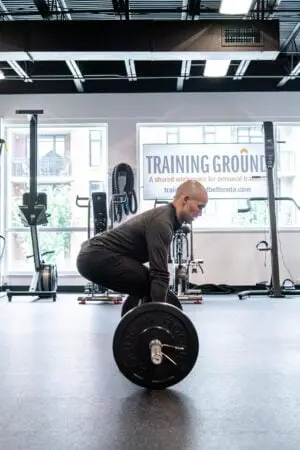It is no secret that runners must complete a strength training program as part of their physical therapy and cross training routine, in addition to their running. Whether through social media, talking with your running friends or coach, or simply your own intuition, every runner has heard that they should be strength training. But is it as simple as picking up a 10-pound dumbbell and knocking out a few squats and deadlifts? Of course not.
There are so many benefits that strength training can offer a runner. Here’s just a few:
- Decreased risk of injury
- Improved running efficiency
- Stronger tendons
Most runners we work with are endurance junkies, they love the feeling of pushing their bodies hard for long periods of time and the feeling of their heart pumping. A big mistake runners often make with their strength training is trying to make it feel like an endurance event, either by doing sets of 20-30 reps or doing circuit-style training with minimal rest.
One key variable is needed to effectively achieve the previously mentioned benefits of strength training: load. Strength training needs to be heavy, challenging the targeted muscles and tendons far beyond what they encounter regularly; otherwise, those tissues have no reason to adapt and get stronger.
Strength training for runners should focus on moderate to heavy weights that allow 6-10 repetitions per set. This range optimizes muscular strength by optimizing the intensity required for muscle adaptation. Additionally, adequate rest between sets (typically 1-2 minutes) allows muscles to recover and perform optimally during subsequent sets.
Remember, the goal of strength training for runners is not to mimic the cardiovascular demands of running but rather to complement it by building foundational strength and resilience in key muscle groups. By prioritizing proper form, progressively increasing the intensity, and allowing for adequate recovery, runners can maximize the benefits of their strength training regimen and enjoy improved performance and longevity in their running careers. Below is an example of a quick lower-body strength training session I recently created for a runner.
A) Heels elevated kettlebell cleans: 2×5
B) Safety Bar Squats (heavy): 3 sets of 6
C1) Kickstand RDL with a dumbbell: 3×8/side
C2) Weighted lateral step downs: 3×8/side
**C1 and C2 are a superset (perform 1 set of the first exercise, then the first exercise of the next exercise before resting and performing round 2)
D1) Prone Hamstring Curls: 3×12
D2) Double leg resisted calf raises (3 seconds on the way down): 3×12
So, next time you hit the gym or dedicate time to strength training at home, focus on lifting heavier weights with proper form and ample rest. Your body will thank you with increased durability and efficiency on the road or trail.
Speaking of durability, we are excited to announce our Running Technique and Performance Lab this Saturday at 10am at our McLean location. We’ve made some thrilling updates! This workshop is a must-attend for any runner aiming to prevent injuries and achieve new personal records this running season. Don’t miss out!
Learn more and sign up by clicking here!
